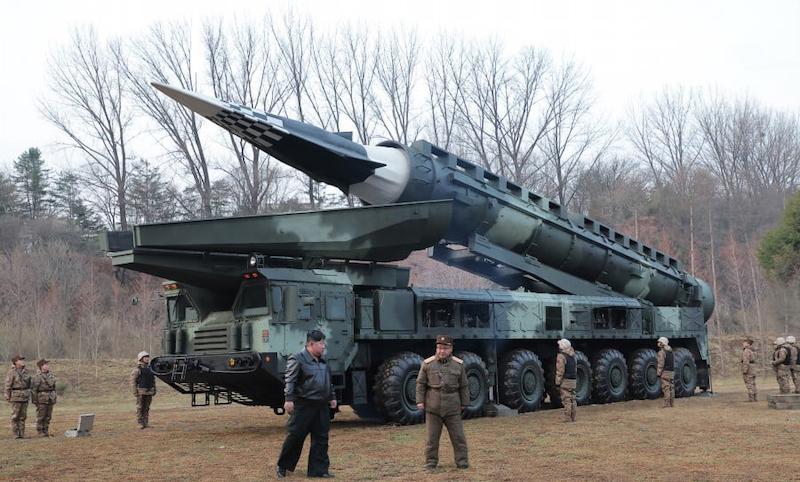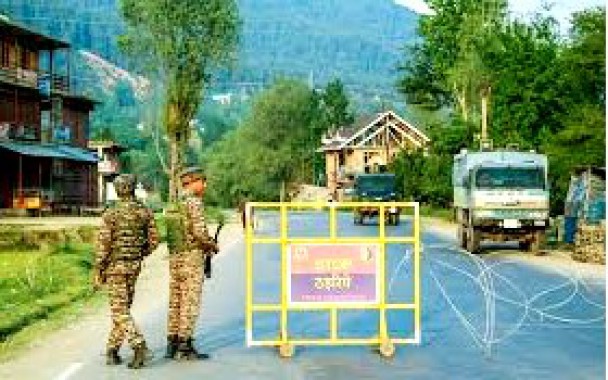SOURCE: RAUNAK KUNDE / NEWS BEAT / IDRW.ORG

In a strategic response to losing the U.S. Air Force’s Next Generation Air Dominance (NGAD) contract to Boeing’s F-47, Lockheed Martin CEO Jim Taiclet has outlined an ambitious plan to transform the F-35 Lightning II into a “fifth-generation plus” platform, positioning it as a cost-effective alternative to sixth-generation fighters. Speaking at Bernstein’s Strategic Decisions Conference on May 28, 2025, Taiclet hinted that new customers, including India, could be offered this enhanced F-35 variant, featuring superior stealth capabilities, new radar-absorbent coatings, and advanced technologies to bridge the gap with next-generation fighters.
With no new sixth-generation fighter or bomber contracts on the horizon, Lockheed Martin is doubling down on its flagship F-35 program, integrating cutting-edge technologies to maintain its relevance in a rapidly evolving global defense landscape.
Continue readingSOURCE: RAUNAK KUNDE / NEWS BEAT / IDRW.ORG

The RGS Division has achieved a significant milestone in India’s pursuit of self-reliance in defence manufacturing with the development of six vehicle sets of the Indigenous Track System for the Main Battle Tank (MBT) Arjun Mk-I. This project, undertaken in collaboration with Indian industry partner M/s Steelcast Ltd., Bhavnagar, Gujarat, is titled “Development of Indigenous Track System for Arjun MBT” and bears the project number CVR-266.
The journey began with M/s Steelcast Ltd. successfully delivering the first vehicle set on February 3, 2023. Following this, the remaining five vehicle sets of tracks were supplied to the Combat Vehicles Research and Development Establishment (CVRDE) by March 20, 2024. These vehicle sets are now available at CVRDE for further integration and testing.
Continue readingSOURCE: AFI

In a remarkable display of precision and strategic prowess, the Indian Air Force (IAF) successfully targeted and destroyed two Hardened and Deeply Buried Targets (HDBTs) during Operation Sindoor. These targets, identified as critical Command and Control (C2) centres for air defence, were located at Chaklala (now Nur Khan Airbase) in Islamabad and Murid Airbase. According to Air Marshal A.K. Bharti, Director General of Military Operations (Air), these facilities were pivotal to Pakistan’s air defence network. However, the author posits that these were likely more advanced Command, Control, Communications, Computers, and Intelligence (C4I) centres, given their strategic significance and observed activities.
Pakistan is known to maintain at least 22 HDBTs, primarily situated around its airbases, with a few in strategic locations like Islamabad and Karachi. These underground facilities are designed to withstand conventional attacks, making their destruction a complex and intelligence-intensive operation. The IAF’s success in targeting these HDBTs underscores the sophistication of its intelligence, surveillance, and reconnaissance (ISR) capabilities and the precision of its weaponry.
Continue readingSOURCE: AFI

In a significant escalation during the India-Pakistan standoff of May 2025, the Indian Air Force (IAF) executed a series of precision strikes under Operation Sindoor, targeting key Pakistan Air Force (PAF) installations, including the strategically vital Murid Air Base in Chakwal, Punjab. Among the high-value targets was a critical Unmanned Aerial Vehicle (UAV) command and control (C2) facility, which is believed to have played a pivotal role in disrupting Pakistan’s drone operations, including its fleet of advanced Turkish-made UAVs such as the Bayraktar TB2 and Akinci.
The operation, launched on May 7, 2025, was a response to a Pakistan-backed terror attack in Pahalgam, Jammu and Kashmir, on April 22, which claimed 26 lives, mostly tourists. A recent report by an Indian government-backed think tank, the Centre for Air Power Studies (CAPS), has confirmed the significant impact of these strikes on Pakistan’s UAV capabilities.
Continue readingSOURCE: AFI

In a significant development amid escalating tensions in South Asia, Pakistan has reportedly approached its long-standing ally, China, to acquire advanced hypersonic missile technology, specifically Hypersonic Glide Vehicles (HGVs), following the failure of its Fatah-I, Fatah-II, and CM-400AKG missiles to penetrate India’s robust air defense systems. Sources indicate that Pakistan intends to rebrand any acquired technology as an indigenous development to bolster its domestic defense narrative, according to information shared with Indian Defence Research Wing (idrw.org).
During the 2025 India-Pakistan conflict, Pakistan deployed its Fatah-I and Fatah-II guided multiple rocket launchers, along with the Chinese-supplied CM-400AKG air-to-surface missile, in attempts to target Indian assets. The Fatah-I, with a range of 140 km, and the Fatah-II, an advanced variant with a 400 km range, were developed as part of Pakistan’s push for self-reliance in precision strike systems. The CM-400AKG, touted by its manufacturer, China’s Aviation Industry Corporation, as a hypersonic missile capable of Mach 5 speeds, was launched from Pakistan’s JF-17 Thunder jets, co-developed with China.
Continue readingSOURCE: AFI

Pakistan’s defense industry is facing a significant setback as production of its Babur and Ra’ad cruise missile systems has reportedly come to a near standstill. The disruption stems from a halt in the supply of critical turbojet engines from Ukraine, a key supplier, due to the ongoing Russia-Ukraine war. This development has raised concerns about Pakistan’s ability to maintain its strategic missile capabilities, which are central to its defense posture against regional rival India.
The Babur (Hatf-VII), a subsonic cruise missile developed by Pakistan’s National Defence Complex (NDC), and the Ra’ad air-launched cruise missile (ALCM), developed by the National Engineering & Science Commission (NESCOM), rely heavily on turbojet engines for their propulsion systems. The Babur, available in ground-launched (Babur-1, 1A, 1B, and 2) and submarine-launched (Babur-3) variants, has a range of up to 900 km and can carry both conventional and nuclear warheads. The Ra’ad (Ra’ad 1 and 2), designed for deployment from Pakistan Air Force (PAF) platforms like the JF-17 and Mirage aircraft, boasts ranges of 350 km and 600 km, respectively. These missiles are critical components of Pakistan’s strategic deterrence, designed to evade and penetrate enemy defenses.
Continue readingPTI
Pakistan launched multiple attacks on early May 10 aiming to bring India to its knees in 48 hours, but it had to fold up the offensives in eight hours and reach out to New Delhi for talks seeking an end to the hostilities, Chief of Defence Staff Gen Anil Chauhan said on Tuesday.
In the first detailed account of India’s clashes with Pakistan, Gen Chauhan said India’s response to the Pahalgam terror attack was to draw “limits of tolerance” to cross-border terrorism and not tolerating Islamabad’s nuclear blackmail.
Continue readingIANS

India has strongly rebutted Pakistan’s 20-page dossier that accuses New Delhi of orchestrating a “false flag” operation in Pahalgam and launching “naked aggression” under Operation Sindoor.
Officials in New Delhi have dismissed the document as a desperate attempt to deflect global attention from Pakistan’s continued sponsorship of cross-border terrorism. According to senior security and diplomatic officials, the Pakistani dossier is riddled with contradictions, denials, and an all-too-familiar narrative of victimhood.
Continue readingIANS

Former Pakistan Foreign Minister Bilawal Bhutto Zardari has conceded that his country hasn’t made headway in its Kashmir campaign at the United Nations and elsewhere in general.
“As far as the hurdles we face within the UN and in general, as far as the Kashmir cause is concerned, that still exists,” Bilawal, who is leading a delegation of Pakistani parliamentarians, said at a news conference here on Tuesday.
Continue readingSOURCE: IANS

Chief of Defence Staff (CDS) General Anil Chauhan on Tuesday drew a striking analogy between cricket and military operations to explain the Indian Armed Forces’ mindset regarding losses and setbacks in conflict.
Speaking at Savitribai Phule Pune University, he said, “Suppose you go in a cricket test match, and you win by any means, then there’s no question of how many wickets, how many balls and how many players.”
Continue readingSOURCE: IANS

In a development that has sparked concern across Pakistan’s social landscape, the federal government under Shahbaz Sharif has recently bestowed the rank of Field Marshal – the nation’s highest military title – upon General Asim Munir, the Chief of Army Staff.
Officially justified on the grounds of his “exemplary leadership” during the latest military confrontation with India, the move has prompted significant debate regarding the future direction of civil-military relations in Pakistan, as well as the military’s increasingly entrenched influence over democratic institutions, which have historically operated under the shadow of the armed forces.
Continue readingSOURCE: IANS

Even as leading warfare experts across the world have exposed Pakistan’s massive strategic failures, at the same time also giving a detailed account of failure of Chinese systems during India’s decisive Operation Sindoor last month, a Pakistani four-star General has claimed that the country fought the recent 96-hour conflict with India using only its own resources.
“Pakistan has purchased some military equipment from other countries, but apart from that, in real time, the country relied solely on its internal capabilities and did not receive any help from any other state,” General Sahir Burkabal Shamshad Mirza, currently serving as the 18th Chairman of the Joint Chiefs of Staff Committee (CJCSC), told a foreign broadcaster in a recent interview, details of which appeared in the Pakistani media on Tuesday.
Continue readingSOURCE: PTI

Land belonging to a terrorist operating from Pakistan-occupied Kashmir (PoK) was attached under the Unlawful Activities Prevention Act (UAPA) in Ramban district of Jammu and Kashmir on Tuesday, police said.
The attachment of the over one-and-a-half kanal of agricultural land owned by PoK settled terrorist Ali Mohd alias Ibrahim Sheikh in Dharamkund’s Sumbar village is a significant move to combat terrorism, a police spokesperson said.
Continue readingSOURCE: PTI

Three Indian nationals who went missing in Iran last month have been rescued, the Iranian embassy in India said on Tuesday, quoting media reports in Tehran.
Last week, the Ministry of External Affairs (MEA) said it was in touch with the Iranian authorities over the missing Indians. “Three missing Indian citizens freed by Tehran police,” the Iranian embassy said in a post on X.
Continue readingSOURCE: IDRW.ORG
BrahMos Aerospace is gearing up for a pivotal test of the BrahMos-NG Submarine-Launched Cruise Missile (SLCM), a next-generation weapon designed to enhance the Indian Navy’s strike capabilities under Project-75I (P-75I). This advanced missile, derived from the BrahMos-NG Air-Launched Cruise Missile (ALCM) variant, is being developed for launch from standard 533mm torpedo tubes, making it a versatile addition to India’s future submarines. As the P-75I program moves toward production, the BrahMos-NG SLCM is set to become a cornerstone of India’s naval deterrence strategy.
The BrahMos-NG SLCM is a compact, supersonic cruise missile based on the next-generation BrahMos-NG platform, itself an evolution of the renowned BrahMos missile. With a weight of approximately 1.5 tons and a range of 400-600 km, the SLCM retains the BrahMos family’s signature features: speeds exceeding Mach 3.5, precision guidance, and the ability to engage both land and naval targets. Its design for torpedo tube launches ensures compatibility with the submarines planned under P-75I, enabling stealthy, long-range strikes from underwater.
Continue reading